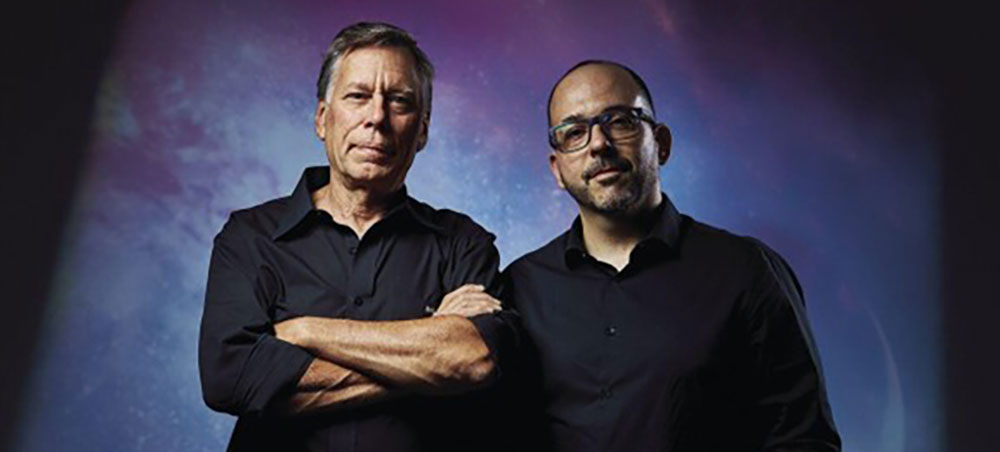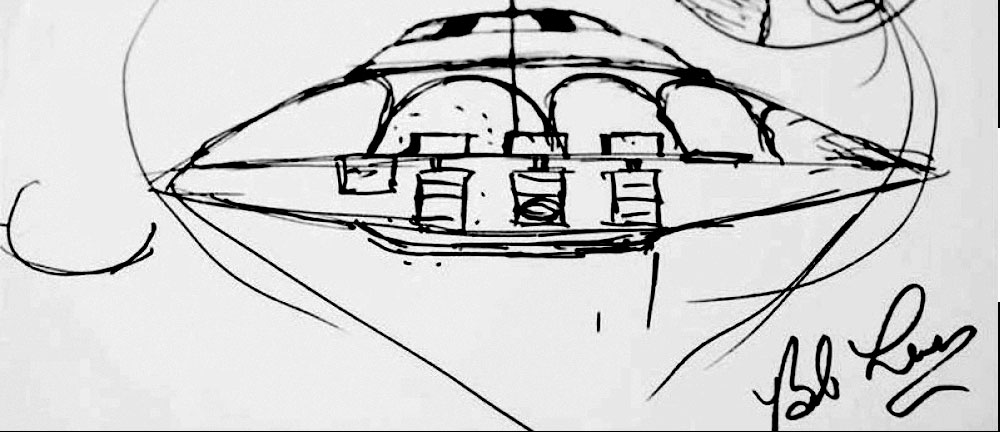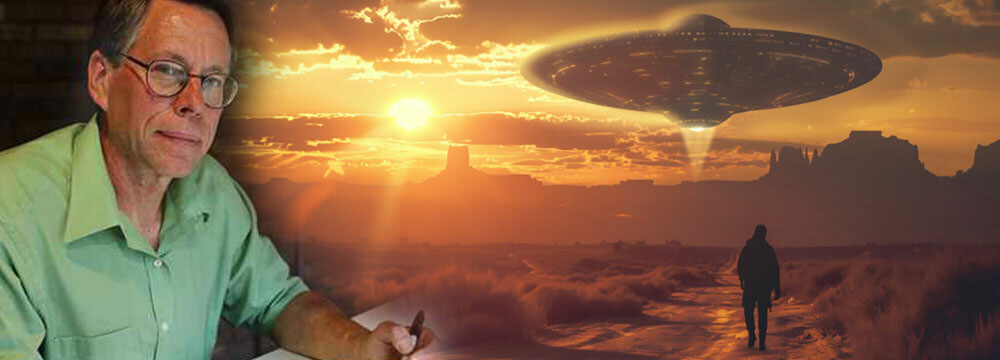The Latest on the Legendary Lazar
Project Gravitaur: Director Luigi Vendittelli talks Bob Lazar, Area 51 and UAP By Maximo Veron and Toby Martinez
In an exclusive interview with the Roswell Daily Record, Documentary Film Director Luigi Vendittelli discussed his upcoming Project Gravitaur, his life as a UAP researcher, and the creation of a revolutionary new way to tell the story of Bob Lazar and his experience working at a top-secret military facility, Area 51.
Vendittelli’s journey into the realm of UFO research and advocacy began at a young age when he became the world’s youngest member of MUFON (Mutual UFO Network) in 1988. This involvement eventually led him to become the national director of MUFON for Canada. However, as time passed, he felt the need to contribute to the field differently.
He decided to leave MUFON and start his initiative, “We Are Not Alone” (WANA), to shed light on the importance of taking UFO and abduction experiences seriously. Through his extensive involvement in investigations and interactions with individuals like David Jacobs and witnesses of events such as the Ariel School incident in Zimbabwe, he realized the profound impact these experiences have on individuals’ lives.
Vendittelli explained, “Witnesses often face ridicule and disbelief, which can be more traumatic than the experiences themselves. This led me to advocate for a more compassionate and understanding approach to these phenomena. I firmly believe in the power of raising awareness and creating a supportive environment for those who have had these experiences.”
Vendittelli met Bob Lazar through a mutual acquaintance at United Nuclear Scientific Equipment & Supplies, a company that Lazar founded. Being a seasoned merchandiser with a background in creating tangible products, he approached Lazar with the idea of producing a high-quality diecast model of a flying saucer based on his experiences. After some initial skepticism, Lazar found the idea intriguing, and they began collaborating. Over several meetings and discussions, they meticulously mapped out the craft and its surroundings, ensuring accuracy down to the smallest detail. Their project expanded beyond just the saucer model to include re-creating the entire Groom Lake and Papoose Lake facilities, which are part of Area 51, in 3D. Utilizing advanced technology and sourcing confidential data, they aimed to create unparalleled realism in their visualization. Lazar provided invaluable insights and guidance throughout the process, ensuring the project stayed true to his experiences. With more than 20 hours of interviews and extensive filming, they are poised to deliver a documentary that informs and immerses viewers in Lazar’s world.
Vendittelli provided a comprehensive overview of the multifaceted approach to presenting Project Gravitaur to the public. The project encompasses three primary components: a documentary film, a virtual reality experience, and a high-quality illustrated book, all offering different avenues for engaging and understanding Lazar’s story.
The documentary film, titled “Lazar: The Original Whistleblower,” serves as the foundational piece of the project, weaving together interviews, cinematic reenactments, and visual effects to immerse viewers in Lazar’s extraordinary story. With distribution plans already in motion, Vendittelli hopes to reach a broad audience through significant streaming platforms, ensuring a wide range of accessibility to the film.
Following the documentary’s release, Project Gravitaur will introduce a virtual reality experience, offering users new and unprecedented levels of immersion and interactivity. Through meticulously recreated environments and interactive elements, participants can explore the facility of S-4, the part of Area 51 that Lazar says he worked at. They will be able to interact with key objects and components and gain firsthand insights into Lazar’s remarkable encounters.
The virtual reality experience promises to be a transformative journey, allowing users to engage with the story in ways previously unimaginable. Whether through mobile devices, computers, or advanced VR headsets, individuals will have the opportunity to delve into the mysteries of S-4 alongside Lazar himself, further enriching their understanding of his story.
Lastly, Project Gravitaur will culminate in releasing a visually stunning illustrated book, providing a tangible and aesthetically captivating companion to the documentary and virtual reality experience. Featuring meticulously crafted illustrations and detailed narratives, the book will offer readers a comprehensive exploration of S-4 and Lazar’s groundbreaking revelations, presented in a format suitable for casual browsing or more profound study.
Vendittelli said that witnessing Lazar’s reaction to the congressional hearings about the “non-human craft” while he was in Montreal with him was truly memorable. He could see the surprise and amazement on Lazar’s face as the discussions about UFO reverse-engineering programs unfolded in Congress. He found it incredibly positive and validating to see such important conversations happening nationally.
Vendittelli explained that Lazar had faced numerous challenges and criticisms over the years, but moments like these gave him a sense of confidence and validation in his own experiences. His respect for George Knapp, who has been instrumental in bringing his story to light, is evident, and he appreciates the efforts made to corroborate his claims.
One particularly significant development, Vendittelli said, was the scientific validation of a data point from Lazar’s accounts in 1989 regarding the Earth’s gravitational wave frequency. He
said that confirmation of this information in an academic paper in 2023 is compelling evidence supporting Lazar’s credibility and accuracy.
Throughout his interactions with Lazar and the time spent working closely with him, Vendittelli has come to know him as a genuine and honest individual. Despite relentless skepticism and attacks from detractors, Lazar remains steadfast in his beliefs and maintains his integrity.
Vendittelli said that he had seen Lazar’s human side firsthand, and it was clear to him that he was not someone who sought attention or fame. His willingness to collaborate on his project was a true

The Latest on the Legendary Lazar
Bob Lazar with Luigi Vendittelli
honor, and he and Vendittelli’s team have developed a close friendship with Lazar over the years.
While some may continue to doubt Lazar’s accounts, Vendittelli firmly believes in his sincerity and honesty. His explanations for omitting certain information, particularly regarding sensitive topics like his educational background, make perfect sense within the context of national security concerns. “In my experience, omitting information does not equate to dishonesty but reflects a sense of responsibility and understanding of the broader implications. Bob’s consistency, natural demeanor, and attention to detail further reinforce my confidence in his authenticity,” assured Vendittelli.
Vendittelli’s perspective on the complexities surrounding government secrecy and the disclosure of classified information aligns with his understanding of the situation. It’s essential to recognize that individuals like Lazar, who have worked within sensitive government programs, operate under strict confidentiality protocols. Revealing classified information can have severe legal and national security implications for the individuals involved and the broader geopolitical landscape.
The idea that the government would willingly disclose all information about classified projects, especially those related to advanced aerospace technology or potential extraterrestrial encounters, is indeed unlikely. Such disclosures could jeopardize national security interests and potentially escalate tensions with other nations.
Furthermore, the involvement of private contractors adds another layer of complexity to the issue. These contractors operate under contracts with the government and are bound by similar confidentiality agreements. The proprietary nature of their work, coupled with national security considerations, creates a significant barrier to full transparency.
While there may be incremental disclosures or acknowledgments of certain phenomena, it’s improbable that the complete truth, including details about advanced technologies or off-world encounters, will be publicly revealed anytime soon. The potential domestic and international ramifications are simply too significant to overlook.
Vendittelli’s insights into the potential involvement of religious institutions, such as the Vatican, in the secrecy surrounding extraterrestrial phenomena add an intriguing dimension to the discussion. Historically, religious organizations have influenced societal beliefs and attitudes, particularly regarding matters of existential significance.
The notion that religious institutions may possess knowledge or have been privy to encounters with extraterrestrial beings raises questions about the intersection of faith, theology, and scientific inquiry. How would adherents of various religious traditions reconcile the existence of intelligent extraterrestrial life with their theological frameworks? Would such revelations challenge fundamental doctrines or provoke theological reinterpretations?
Furthermore, the potential implications for public perception and societal stability cannot be overstated. The disclosure of information suggesting direct interactions between religious figures and extraterrestrial entities could have profound ramifications for individuals’ faith, cultural identities, and social cohesion.
“In navigating these complexities, it is essential to maintain a balanced and critical perspective, acknowledging the potential for paradigm-shifting revelations while exercising caution against embracing unfounded assertions or simplistic narratives. Pursuing truth requires a nuanced understanding of the interplay between various factors shaping our understanding of the cosmos and our place within it.” Vendittelli concludes.

Drawing of an alien space ship by Bob Lazar





 KGRA Digital Broadcasting
KGRA Digital Broadcasting KGRA Digital Broadcasting
KGRA Digital Broadcasting